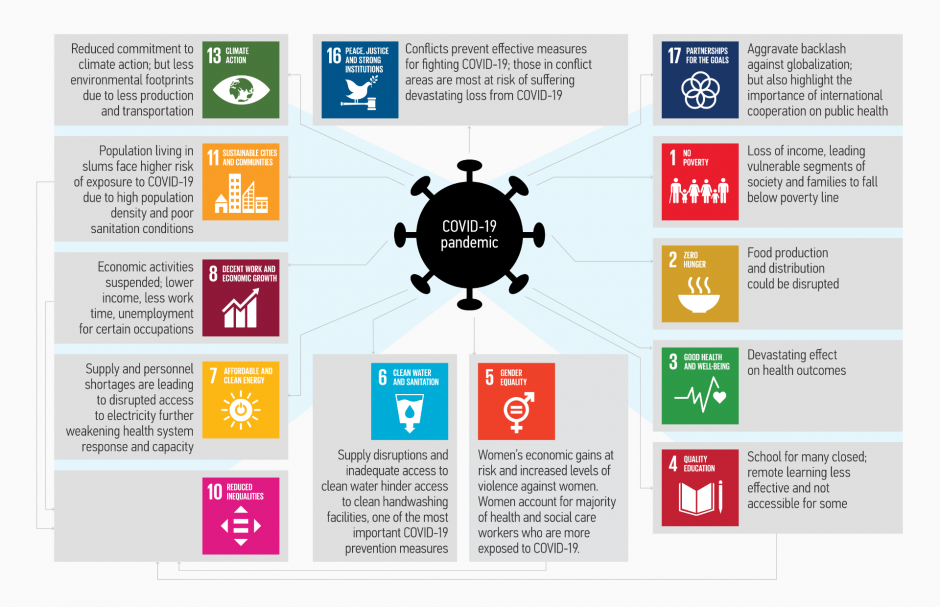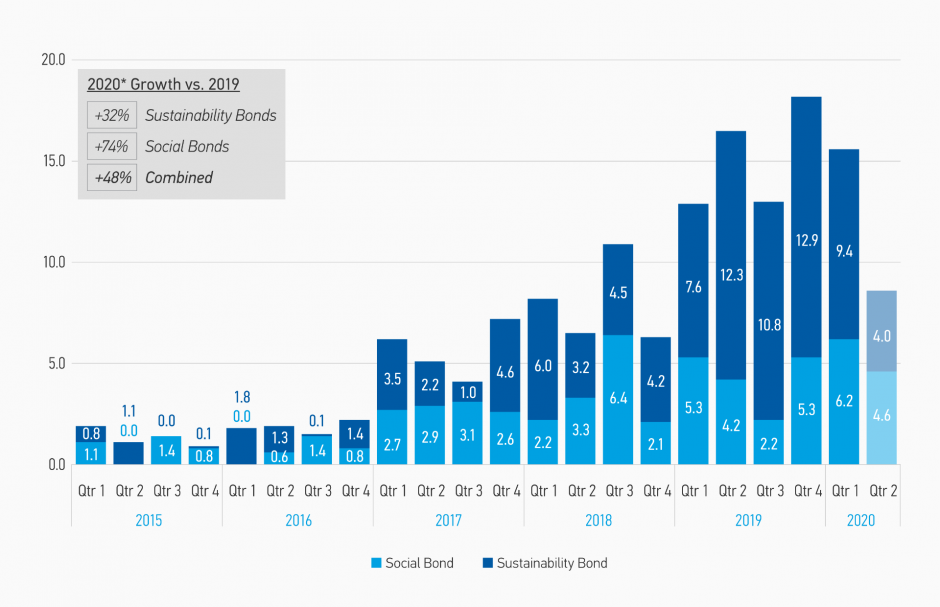
Morgan Stanley: The Butterfly Effect & COVID-19 - Six Implications for Sustainable Investing in an Interconnected World
COVID-19 is a disruption event with enormous personal, societal and economic repercussions, the origins and effects of which are amplified by an increasingly interconnected world. As fixed income investors, we are closely monitoring the near-term and longer-term consequences, and in particular, we are watching six implications of the pandemic for sustainable investing.
14.05.2020 | 13:05 Uhr
Navindu Katugampola, Executive Director
Global Fixed Income Team
Many commentators have used the metaphor of a grey rhino to describe the COVID-19 pandemic. Like a cross between an elephant and a black swan, this event was a “highly probable, high impact yet neglected threat.”1 (Notably many have also used this metaphor to describe the threat of climate change.)
The threat of a serious pandemic has indeed existed for some time. Since the turn of the century we have seen several precursors of large-scale infectious disease, from the 2002 SARS outbreak to the 2009 H1N1 swine flu pandemic and the 2015 Ebola epidemic in West Africa. The grey rhino metaphor, however, is incomplete and fails to acknowledge the complexity of global interconnectedness.
Rather, this COVID-19 pandemic would be better described by Edward Lorenz’s “butterfly effect.”2 The current crisis started in a provincial market in China, but spread rapidly round the world through travel routes and supply chains. There is also clear scientific evidence that the spread of diseases like COVID-19 can be exacerbated by rising temperatures3, deforestation,4 loss of biodiversity,5 and poor sanitation6—all of which are prominent, interconnected sustainability issues.
The idiosyncratic, nonlinear nature of a systemic risk like a pandemic makes it challenging to predict where, when and to what extent the effects will be felt. However, understanding and addressing such risks are integral components of sustainable investing. Furthermore, through deploying capital in a way that reduces sustainability risks and drives positive outcomes, sustainable investing can help mitigate the underlying social and environmental conditions that fuel the speed and intensity at which disasters become catastrophes.
As fixed income investors, we are closely monitoring the near-term and longer-term consequences of COVID-19, and in particular, we are watching six implications for sustainable investing.
IMPLICATION 1
COVID-19 has intensified sustainability challenges, requiring significant financing in the bond markets to address.
In the near term, focus has understandably turned from the origins of COVID-19 to the sustainability challenges that it has caused and aggravated. The most obvious impacts of the pandemic have been its social and economic costs—primarily the terrible loss of life, as well as the follow-on effects of rising unemployment, food insecurity, and related health outcomes. According to the United Nations (UN), the pandemic has negatively impacted 13 of the 17 Sustainable Development Goals (SDGs),7 as shown in Display 1.
Display 1: Socio-economic impacts of COVID-19 based on the Sustainable Development Goals

Source: UNDESA. The content of this publication has not been approved by the United Nations and does not reflect the views of the United Nations or its officials or Member States” See https://www.un.org/sustainabledevelopment/sustainable-development-goals for more details on the Sustainable development goals icons.
In an effort to drive capital to address these issues, the International Capital Markets Association (ICMA) has published guidance for the issuance of social bonds to finance the COVID-19 response, and some external verifiers are revising their methodologies for assessing the eligibility of these activities. We had already been seeing a steady rise in social and sustainability bond issuance ahead of the pandemic, as investors increasingly focused on social as well as environmental issues; however this trend has now sharply accelerated with themed bond issuance in response to COVID-19 (see Display 2), from supranationals (53 percent of YTD issuance), public agencies8 (29 percent) and corporates (17 percent), as well as increased government bond issuance. Fixed Income investors will therefore be at the forefront of providing financing to address the immediate sustainability challenges caused by the pandemic.
Display 2: Global issuance of Social and Sustainability Bonds since 2015 (US$ billion)

* Note: Q2 2020 as of April 20, 2020.
Source: Data from Environmental Finance.
IMPLICATION 2
Sustainable investing will play a defining role in shaping the recovery.
The COVID-19 pandemic has temporarily arrested economic activity; however, the massive fiscal response globally will drive the recovery. But what will the recovery look like? One of the silver linings of recent social distancing measures has been the temporary reduction in greenhouse gas emissions; however, the urgency of stimulating economic recovery may very well delay progress on global climate change initiatives and policies. Positive signals are coming from regulators. In Europe, for example, the European Commission has continued its focus on a Sustainable Finance Strategy and on establishing a long-term framework to achieve climate neutrality in the EU by 2050, highlighting the need for integration of green transition principles into the Union’s economic stimulus package. The investment community will have a pivotal role to play in supporting these initiatives by allocating capital towards constructing a stable and sustainable recovery, which will be financed primarily in the bond markets.
IMPLICATION 3
Integration of sustainability considerations into valuation and risk/return models.
COVID-19 has resulted in increased scrutiny on companies—as well as governments—regarding progress towards sustainability targets and contingency plans in place related to sustainability risks. We believe organisations that will emerge successfully from this crisis are the ones that have gone the extra mile in establishing strong environmental, social and governance (“ESG”) practices—for example, ensuring labour standards are not compromised along stressed supply chains; responding to employees’ uncertainty around job stability,9 which can otherwise hinder productivity; and maintaining continuity of operations. Companies that have invested in social inclusion and in expanding access to essential goods and services—such as healthcare and digital/ telecommunications—may benefit from both a more stable consumer base and reputational benefits. Innovation as well as transferability of skills and technology are also proving to be determinants of business resilience.
Along with social considerations, corporate governance and how executives navigate the crisis are being closely monitored. Against a backdrop of a highly stressed economic and operating environment, large corporate payouts are being scrutinised, prompting a number of CEOs of large multinational companies to make public announcements about their voluntary pay cuts, and provide detailed justifications for dividend pay-out decisions.
As investors, we have to incorporate these resurgently material ESG factors into our assessment of risk/return for issuers. For example, the Global Fixed Income Team at MSIM has developed a proprietary model that integrates ESG considerations into its valuation methodology, utilizing a combination of independent third-party data, the expertise of our Research team, and dynamic assessments of sustainability momentum and controversies. This allows us to objectively determine how sustainability factors might affect the value and liquidity of our investments.
IMPLICATION 4
Increasing role of active engagement by fixed income investors, especially on social issues.
The impacts of climate change have rightfully brought environmental risks to the forefront of investment considerations in recent years; however, as we highlighted above, renewed social and governance issues have come to the forefront as a result of the COVID-19 pandemic. This is not a new concept. For example, the Principles for Responsible Investment (PRI), which MSIM has been a signatory since 2013, has encouraged investors to engage with companies that are neglecting their workers’ safety or favouring executive pay and dividend payments over business sustainability.10
Given the expectation that financing the pandemic response and recovery will primarily occur through debt issuance, Fixed Income investors will be asked to invest more of their capital and more often, increasing the level of dialogue and influence they have with issuers. The Global Fixed Income team adopts a proactive approach to engagement, implemented in partnership with the MSIM Global Stewardship team, with the firm belief that this improves and informs our investment process, as well as helps drive positive sustainability outcomes and improved issuer fundamentals.
IMPLICATION 5
Improved holistic risk assessment and disclosure practices from companies.
Our collective understanding of climate risk has evolved significantly over the past decade through collaboration among scientific, academic, intergovernmental, regulatory and industry bodies.11 As a result, we have seen new holistic approaches to assessing climate risk, such as the framework established by the Financial Stability Board’s (FSB) Taskforce on Climate-Related Financial Disclosure (TCFD), which requires consideration of both transition and physical risks.
Such frameworks allow companies to understand their true exposure and vulnerability to climate risk and communicate this effectively with investors. With new awareness of infectious disease risk, in particular, we anticipate the need for companies to develop and communicate holistic risk models applied to other high-impact/ high-likelihood sustainability risks beyond climate change.
For Fixed Income investors, who are primarily focused on the return and liquidity of their holdings, these holistic risk-assessment models would give us a clearer idea in advance of how an issuer’s bonds might behave in a stressed scenario, and also allow us to critically assess whether the spread we are earning sufficiently compensates us for this risk.
IMPLICATION 6
Greater investor focus on preparedness and resilience in the face of long-term risks.
Many sustainability issues like health, inequality and climate change are inherently long-term, with impacts and solutions playing out over decades. However, associated risks such as infectious disease outbreaks, social unrest and weather events can manifest more severely in the short term. Much as companies develop Business Continuity Plans to manage disruptions, we expect investors to systematically account for resilience. The goal is not to eliminate risk, but to minimize disruption and ensure a smoother recovery when disruptions do occur. Investors do not expect companies to anticipate all the possible consequences when the butterfly beats its wings, but they will expect them to identify and address the areas where the effects may be most acutely felt. For Fixed Income investors, a greater focus on resilience in the long run may translate into more stable cash flows, less price volatility on bonds, and lower default rates.
Conclusions
With many sustainability challenges like climate change, the effects might already be visible—for example, rising sea levels, changing weather, and an increase in wildfires. However, the major and potentially more disastrous consequences may only become apparent in years to come. In contrast, the accelerated impacts of COVID-19 have had an immediate and profound effect. We believe this stark warning will serve as a wake-up call, driving a further modal shift towards sustainable investing and a renewed focus on sustainability risks and opportunities. This, in turn, should help accelerate the global recovery from the pandemic and build a more resilient society and economy for the future.
1 “The Grey Rhino: How to Recognise and Act on the Obvious Dangers We Ignore,” Michele Wucker, St Martin’s Press, 2016.
2 Lorenz, Edward N. (March 1963). “Deterministic Nonperiodic Flow.” Journal of the Atmospheric Sciences. 20 (2): 130–141.
3 Scientific study that as temperatures rise, seasons lengthen and the conditions for vector-borne disease transmission persist longer and spread further. See Caminade, Cyril et al. (March 2014) “Impact of climate change on global malaria distribution”. Proceedings of the National Academy of Sciences of the United States of America, 111 (9).
4 Scientific study that deforestation is directly linked to the spread of diseases, as carriers of disease such as mosquitoes, bats and primates concentrate in the remaining forest fragments and come into closer contact with humans. See Fornace, Kimberly M et al. (February 2016) “Association between Landscape Factors and Spatial Patterns of Plasmodium knowlesi Infections in Sabah, Malaysia.” Emerging Infections Diseases Journal, 22 (2).
5 Scientific publication highlighting that a loss of biodiversity can cause disease-transmitting species to thrive and proliferate, as well as negatively impact biomedical research and medicine development, food production and security. See “Sustaining Life: How Human Health Depends on Biodiversity,” Eric Chivian and Aaron Bernstein, 2008.
6 Scientific study showing that poor sanitation can accelerate and intensify the spread of disease, such as the Zika virus in the favelas of Brazil in 2015. See Lowe, Rachel et al. (January 2018) “The Zika Virus Epidemic in Brazil: From Discovery to Future Implications.” International Journal of Environmental Research and Public Health. 15 (1).
7 “Shared Responsibility, Global Solidarity: Responding to the Socio-Economic Impacts of COVID-19,” UNDP, March 2020.
8 Including municipalities.
9 According to ILO estimates, global unemployment could increase by almost 25 million as a result of the economic and labour crisis created by COVID-19, in a worst-case scenario.
10 “How Responsible Investors Should Respond to the COVID-19 Coronavirus Crisis,” PRI, 27 March 2020.
11 For example, the United Nations, the Intergovernmental Panel on Climate Change (IPCC), the Financial Stability Board’s Taskforce on Climate-related Financial Disclosure (TCFD), and the Network for Greening the Financial System (NGFS).
Here you can find the complete article.
Risk Considerations
There is no assurance that a portfolio will achieve its investment objective. Portfolios are subject to market risk, which is the possibility that the market values of securities owned by the portfolio will decline and that the value of portfolio shares may therefore be less than what you paid for them. Market values can change daily due to economic and other events (e.g. natural disasters, health crises, terrorism, conflicts and social unrest) that affect markets, countries, companies or governments. It is difficult to predict the timing, duration, and potential adverse effects (e.g. portfolio liquidity) of events. Accordingly, you can lose money investing in this portfolio. Please be aware that this portfolio may be subject to certain additional risks.
Fixed-income securities are subject to the ability of an issuer to make timely principal and interest payments (credit risk), changes in interest rates (interest-rate risk), the creditworthiness of the issuer and general market liquidity (market risk). In a rising interest-rate environment, bond prices may fall and may result in periods of volatility and increased portfolio redemptions. In a declining interest-rate environment, the portfolio may generate less income. Longer-term securities may be more sensitive to interest rate changes. ESG Strategies that incorporate impact investing and/or Environmental, Social and Governance (ESG) factors could result in relative investment performance deviating from other strategies or broad market benchmarks, depending on whether such sectors or investments are in or out of favor in the market. As a result, there is no assurance ESG strategies could result in more favorable investment performance.
IMPORTANT DISCLOSURES:
Past performance is no guarantee of future results.
The views, opinions, forecasts and estimates expressed of the author or the investment team as of the date of preparation of this material and are subject to change at any time due to market, economic or other conditions. Furthermore, the views will not be updated or otherwise revised to reflect information that subsequently becomes available or circumstances existing, or changes occurring, after the date of publication. The views expressed do not reflect the opinions of all portfolio managers at Morgan Stanley Investment Management (MSIM) or the views of the firm as a whole, and may not be reflected in all the strategies and products that the Firm offers.
Forecasts and/or estimates provided herein are subject to change and may not actually come to pass. Information regarding expected market returns and market outlooks is based on the research, analysis and opinions of the authors. These conclusions are speculative in nature and are not intended to predict the future performance of any specific Morgan Stanley Investment Management product.
Certain information herein is based on data obtained from third-party sources believed to be reliable. However, we have not verified this information, and we make no representations whatsoever as to its accuracy or completeness.
This material is a general communication, which is not impartial, and all information provided has been prepared solely for informational and educational purposes and does not constitute an offer or a recommendation to buy or sell any particular security or to adopt any specific investment strategy. The information herein has not been based on a consideration of any individual investor circumstances and is not investment advice, nor should it be construed in any way as tax, accounting, legal or regulatory advice. To that end, investors should seek independent legal and financial advice, including advice as to tax consequences, before making any investment decision.
This communication is not a product of Morgan Stanley’s Research Department and should not be regarded as a research recommendation. The information contained herein has not been prepared in accordance with legal requirements designed to promote the independence of investment research and is not subject to any prohibition on dealing ahead of the dissemination of investment research.




Diesen Beitrag teilen: